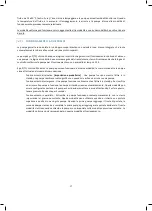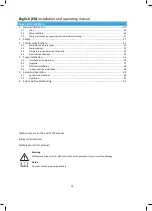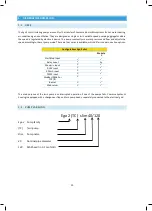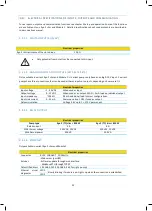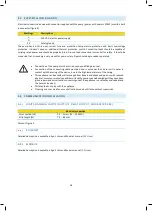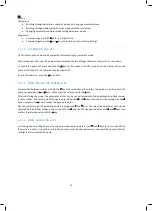
26
4
PUMP INSTALLATION
4.1
INSTALLATION INTO PIPE LINES
Pump is protected with a double box during transport. It can be lifted from the box with internal handles or by
lifting it by the heat sink.
Pumps are designed to be built in connecting flanges, using all screws. The connecting combined flanges are
designed so the pump can be installed PN10 nominal pressure pipelines. Because of the combined flange design,
washers must be used on the pump side, when installing the pump.
For a pump to operate with minimal vibrations and noise it should be installed into pipe lines with its axis in
horizontal position, as showed in figure 1. Pipes should be without curves for at least 5-10 D (D = rated pipe
diameter) from the flanges.
Desired head orientation can be achieved by rotating the pump head (allowed pump positions shown in figure
2 and 3). Pump head is mounted to hydraulic casting with four screws. By unscrewing those, the pump head can
then be turned (figure 4).
Ambient around the pump should be dry and illuminated as appropriate and the pump should not be in direct
contact with any objects. Pump seals prevents dust and particles from entering as prescribed by IP class. Make
sure that the distribution box cover is mounted and that the cable glands are tightened and are sealing.
Pump will provide the longest lifetime with ambient at room temperature and moderate medium temperature.
Prolonged operation at elevated temperatures could increase wear. Aging is accelerated by high power and high
temperatures.
•
Misconnection or overload could cause pump shutdown or even permanent damage.
•
Pumps might be heavy. Provide yourself help if needed,
•
Pump must not be used in the safety pipelines,
•
Pump should not be used as a holder during welding!
•
When reassembling, care should be taken to ensure seal fit. Failing that, water could
cause damage to pumps internal parts,
•
Drains between pump motor housing and hydraulic housing must be left free (should
not be thermally insulated), as it could interfere with cooling and condense drainage
(figure 1
)
,
•
Hot medium can cause burns! The motor can also reach temperatures that could cause
injury.
•
Motor hosuing should not be termo isolated
Summary of Contents for Ego 2 slim
Page 91: ...91 EGO 2 TC SLIM 32 120...
Page 92: ...92 EGO 2 TC SLIM 40 40...
Page 93: ...93 EGO 2 TC SLIM 40 80...
Page 94: ...94 EGO 2 TC SLIM 40 120...
Page 95: ...95 EGO 2 TC SLIM 40 180...
Page 96: ...96 EGO 2 TC SLIM 50 40...
Page 97: ...97 EGO 2 TC SLIM 50 80...
Page 98: ...98 EGO 2 TC SLIM 50 120...
Page 99: ...99 EGO 2 TC SLIM 50 180...
Page 100: ...100 EGO 2 TC SLIM 65 40...
Page 101: ...101 EGO 2 TC SLIM 65 80...
Page 102: ...102 EGO 2 TC SLIM 65 120...
Page 103: ...103 EGO 2 TC SLIM 65 180...
Page 104: ...104 EGO 2 TC SLIM 80 40...
Page 105: ...105 EGO 2 TC SLIM 80 80...
Page 106: ...106 EGO 2 TC SLIM 80 120...
Page 107: ...107 EGO 2 TC SLIM 80 180...
Page 108: ...108 EGO 2 TC SLIM 100 40...
Page 109: ...109 EGO 2 TC SLIM 100 80...
Page 110: ...110 EGO 2 TC SLIM 100 120...
Page 111: ...111 EGO 2 TC SLIM 100 180...
Page 112: ...112 SLIKE PICTURES BILDER IMMAGINI KUVAT SLIKE 1 A...
Page 113: ...113 2...
Page 114: ...114 3...
Page 115: ...115 4 5 90...
Page 116: ...116 Ego 2 TC slim 200W Ego 2 TC slim 850W 6...
Page 117: ......






